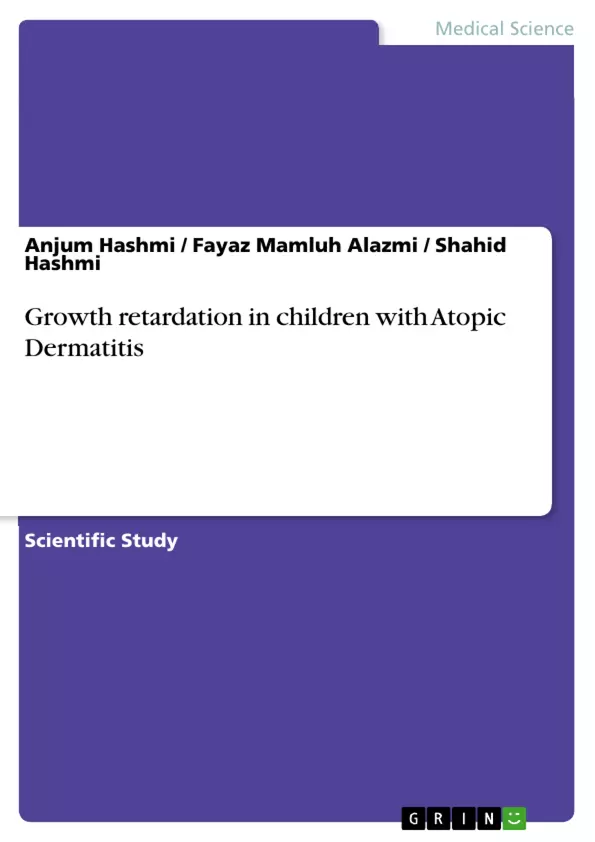The objective of this study was to determine the frequency of growth retardation in children with moderate to severe atopic dermatitis.
Forty children with atopic dermatitis fulfilling the inclusion criteria were entered in the study. Their height was recorded and growth charts were selected according to the age and gender of the patients. The results show growth retardation in children with atopic dermatitis. The frequency of the growth impairment was relatively more in severe disease and among girls, as depicted by growth charts.
Inhaltsverzeichnis (Table of Contents)
- ABSTRACT
- INTRODUCTION
- REVIEW OF LITERATURE
- ATOPIC DERMATITIS
- EPIDEMIOLOGY
- ETIOLOGY AND PATHOGENESIS
- EXACERBATING FACTORS FOR ATOPIC DERMATITIS
- HISTOPATHOLOGY OF ATOPIC DERMATITIS
- DIAGNOSIS OF ATOPIC DERMATITIS
- DIFFERENTIAL DIAGNOSIS OF ATOPIC DERMATITIS
- COMPLICATIONS OF ATOPIC DERMATITIS
- GROWTH IMPAIRMENT
- ASSESSMENT OF GROWTH
- OBJECTIVE
- OPERATIONAL DEFINITIONS
- ATOPIC DERMATITIS
- SEVERITY
- GROWTH RETARDATION
- MATERIAL AND METHODS
- SETTING
- DURATION OF STUDY
- SAMPLE SIZE
- SAMPLING TECHNIQUE
- STUDY DESIGN
- SAMPLE SELECTION
- DATA ANALYSIS
- FREQUENCY OF GROWTH RETARDATION IN CHILDREN WITH MODERATE TO SEVERE ATOPIC DERMATITIS
- RESULTS
- DISCUSSION
- CONCLUSION
- REFERENCES
Zielsetzung und Themenschwerpunkte (Objectives and Key Themes)
This study aimed to determine the frequency of growth retardation in children with moderate to severe atopic dermatitis. It was conducted as a cross-sectional survey at WAPDA Hospital, Lahore. The study included 40 children with atopic dermatitis who met the inclusion criteria. Height and weight were measured using appropriate tools, and growth charts were used to assess growth retardation based on percentile ranks.
- Growth retardation in children with atopic dermatitis
- Prevalence of growth impairment in relation to disease severity
- Assessment of growth using standardized growth charts
- Impact of atopic dermatitis on child development
- Exploring potential factors contributing to growth retardation in children with atopic dermatitis
Zusammenfassung der Kapitel (Chapter Summaries)
The study begins with a comprehensive review of the literature on atopic dermatitis, including its epidemiology, etiology, pathogenesis, exacerbating factors, histopathology, diagnosis, differential diagnosis, and complications. The study's methodology is then outlined, detailing the setting, duration, sample size, sampling technique, study design, sample selection, and data analysis procedures. The results section presents the findings regarding the frequency of growth retardation in children with moderate to severe atopic dermatitis. The discussion section analyzes these results, exploring the implications of the findings and potential contributing factors to growth retardation in children with atopic dermatitis. The study concludes with a summary of the key findings and their significance.
Schlüsselwörter (Keywords)
The study revolves around the key concepts of atopic dermatitis, growth retardation, growth charts, and the impact of atopic dermatitis on child development. It explores the prevalence of growth impairment in relation to disease severity and analyzes potential contributing factors to growth retardation in children with atopic dermatitis.
- Quote paper
- Anjum Hashmi (Author), Fayaz Mamluh Alazmi (Author), Shahid Hashmi (Author), 2016, Growth retardation in children with Atopic Dermatitis, Munich, GRIN Verlag, https://www.grin.com/document/340946



